Plot
On 6 September 1950, an isolated and exhausted platoon of the 24th Infantry Division is cut off. In addition to losing radio contact, the platoon is harassed by unseen North Korean infiltrators who silently kill the Americans and take their weapons. Platoon leader Lieutenant Benson has only vague instructions to reach a certain hill to link up with American forces.
The patrol stops a jeep driven by Staff Sergeant "Montana" and shell shocked passenger "the Colonel" from the First Cavalry Division. The Colonel is unable to speak and is tied to his seat. After the Battle of the Nakdong River, where "our men fell like rain", the tough experienced Montana decided he and his Colonel, whom he treats like his father, have had enough of the war. Benson commandeers their jeep for his platoon's equipment and the battle-fatigued Corporal Zwickley.
The platoon makes its way towards the hill. Montana disobeys Benson by instinctively shooting a surrendering North Korean sniper, who turns out to have a concealed weapon inside his hat. Sergeant Killian is killed while covering the rear after absentmindedly filling his helmet net with flowers. Montana takes his place and feigns fatigue, luring the infiltrators into the open, where he kills them.
The cynical Montana transforms the platoon back into a military formation while also curing Zwickley's neurosis by slapping him around. The platoon successfully carries on through sniper attack, artillery barrage, and land mines during which Platoon Sergeant Lewis panics and is killed.
When they reach the hill, they find it held by the North Koreans. Montana shoots three enemy soldiers disguised as Americans after a North Korean prisoner is used as bait and killed by his own men. Benson and his men launch an attack, but Montana and the Colonel sit it out. The Colonel comes to his senses, joins the assault, and is killed. Shamed, Montana joins Benson. They use grenades and a flamethrower to destroy a pillbox and machine gun nest.
Only Benson, Montana, and Sergeant Riordan survive. When American reinforcements arrive, Montana produces a container of medals that the Colonel meant to award his men. Benson calls the roll of the men in his platoon in alphabetic order (including those killed in the attack) as Montana throws the medals to the dead on the slope of the hill.
Production
Unable to get tanks and military extras from the Pentagon, both Mann and composer Bernstein [6] concentrate on the landscape, in this case filmed at Bronson Canyon. Enemy soldiers are rarely seen, and the isolation of the platoon is strongly conveyed. Mann had previously made film noirs in the late 1940s and Westerns in the early to mid-1950s and combined elements of both in his first war film.
Phil Yordan later recalled he wrote the film at 150 pages then Mann "went through the script, he reduced it to eighty-two pages. He threw out all the dialogue. Of course, I put all of the dialogue back in to get Aldo Ray and Robert Ryan to play it. I said to him, "What am I going to do if you send them this script? They won't show up!" [7]
Mann later said "I wanted to tell a story of the detail of war. The detail of war is what all the soldiers went through: that they had sand in their boots; that their gun jammed; that they took off their helmets at the wrong time; that they had to walk through forests of mines; or walk through bombardments. I was interested only in the foot soldier. Nobody knows why they have to take such and such a hill. They just are told to take it. So I lived with the guys, and I wanted to tell the story through tiny personal incidents.I used simple people - and did it all in twenty-four days. Actually, we had two units working side by side. I think it did come off." [8]
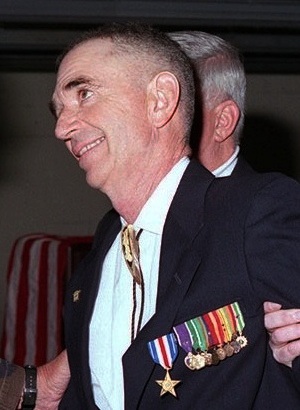
Carlos Norman Hathcock II was a United States Marine Corps (USMC) sniper with a service record of 93 confirmed kills. Hathcock's record and the extraordinary details of the missions he undertook made him a legend in the U.S. Marine Corps. He was honored by having a rifle named after him: a variant of the M21 dubbed the Springfield Armory M25 White Feather, for the nickname "White Feather" given to Hathcock by the North Vietnamese People's Army of Vietnam (PAVN).
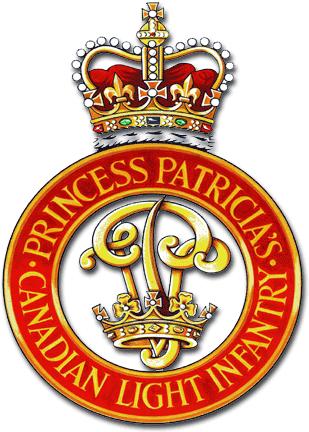
Princess Patricia's Canadian Light Infantry is one of the three Regular Force infantry regiments of the Canadian Army of the Canadian Armed Forces. Formed in 1914, it is named for Princess Patricia of Connaught, daughter of the then-Governor General of Canada. The regiment is composed of three battalions, for a total of 2,000 soldiers. The PPCLI is the main lodger unit of Canadian Forces Base (CFB) Edmonton in Alberta and CFB Shilo in Manitoba, and attached to 3rd Canadian Division; as such, it serves as the "local" regular infantry regiment for much of Western Canada. The Loyal Edmonton Regiment (LER), a Reserve Force battalion, is affiliated with the PPCLI but is not formally part of it. As part of this affiliation, the LER carries the designation '4th Battalion, Princess Patricia's Canadian Light Infantry'.

Aldo Ray was an American actor of film and television. He began his career as a contract player for Columbia Studios before achieving stardom through his roles in The Marrying Kind, Pat and Mike, Let's Do It Again, and Battle Cry. His athletic build and gruff, raspy voice saw him frequently typecast in "tough guy" roles throughout his career, which lasted well into the late 1980s. Though the latter part of his career was marked by appearances in low-budget B-movies and exploitation films, he still appeared occasionally in higher-profile features, including The Secret of NIMH (1982) and The Sicilian (1987).
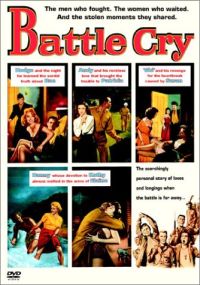
Battle Cry is a 1955 Warnercolor film, starring Van Heflin, Aldo Ray, James Whitmore, Tab Hunter, Nancy Olson, Anne Francis, Dorothy Malone, Raymond Massey, and Mona Freeman in CinemaScope. The film is based on the 1953 novel by former Marine Leon Uris, who also wrote the screenplay, and was produced and directed by Raoul Walsh. The film was shot at Camp Pendleton, California, and featured a large amount of cooperation from the United States Marine Corps.

The Thin Red Line is a 1964 American war film directed by Andrew Marton and starring Keir Dullea, Jack Warden, James Philbrook, and Kieron Moore. Based on James Jones's 1962 novel of the same name, the film follows the lives of a number of American soldiers during the battle of Guadalcanal.
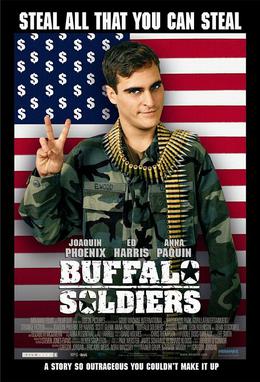
Buffalo Soldiers is a 2001 black comedy war film directed and co-written by Gregor Jordan, based on the 1993 novel of the same name by Robert O'Connor. The film stars Joaquin Phoenix, Ed Harris, Scott Glenn, Anna Paquin and Dean Stockwell. It follows a group of American soldiers stationed in West Germany during 1989 just before the fall of the Berlin Wall.

Platoon Leader is a 1988 war film set in the Vietnam War and directed by Aaron Norris ; it stars Michael Dudikoff and Michael DeLorenzo and was filmed in South Africa. It is loosely based on James R. McDonough's memoir of the same name.
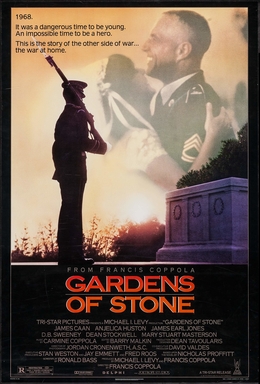
Gardens of Stone is a 1987 American drama film directed by Francis Ford Coppola, based on a novel of the same name by Nicholas Proffitt. It stars James Caan, Anjelica Huston, James Earl Jones, D. B. Sweeney, Dean Stockwell and Mary Stuart Masterson.

The Steel Helmet is a 1951 American war film directed, written, and produced by Samuel Fuller during the Korean War. The cast stars Gene Evans, Robert Hutton, Steve Brodie, James Edwards, and Richard Loo. It was the first American film about the war and the first of several war films by Fuller.

The 5th Infantry Regiment is an infantry regiment of the United States Army that traces its origins to 1808.

All the Young Men is a 1960 American Korean War feature film directed by Hall Bartlett and starring Alan Ladd and Sidney Poitier dealing with desegregation in the United States Marine Corps. Poitier plays a sergeant unexpectedly placed in command of the survivors of a platoon in the Korean War. The film explores the racial integration of the American military, centering on the African-American sergeant's struggle to win the trust and respect of the men in his unit.
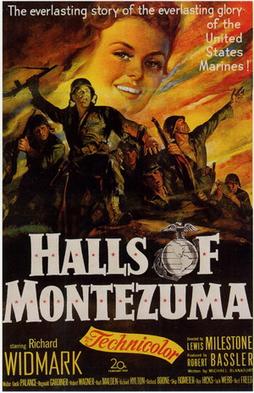
Halls of Montezuma is a 1951 American World War II war film directed by Academy Award-winner Lewis Milestone and starring Richard Widmark. It also stars Robert Wagner in his first credited screen role and features Richard Boone in his feature-film debut. The story is about U.S. Marines fighting on a Japanese-held island, and the title is a reference to the opening line from the Marines' Hymn.

Kazuo Otani was a United States Army soldier and a recipient of the United States military's highest decoration—the Medal of Honor—for his actions in World War II.

Between Heaven and Hell is a 1956 American Cinemascope war film based on the novel The Day the Century Ended by Francis Gwaltney that the film follows closely. The story is told in flashback format detailing the life of Sam Gifford from his life as a Southern landowner to his war service in the Philippines during World War II.

The Naked and the Dead is a 1958 World War II film directed by Raoul Walsh, and based on the 1948 novel of the same name by Norman Mailer. The screenplay was written by brothers Denis and Terry Sanders, and the film was shot in Panama on Technicolor film. The movie adds a strip tease and an action scene to the story in the novel. It is one of the last films produced by RKO before the studio's closure. The film was released by Warner Bros. It was the last film that Walsh directed for Warner Bros.

Many films, books, and other media have depicted the 1950—53 Korean War. The TV series M*A*S*H is one well known example. The 1959 novel The Manchurian Candidate has twice been made into films. The 1982 film Inchon about the historic battle that occurred there in September 1950 was a financial and critical failure. By 2000 Hollywood alone had produced 91 feature films on the Korean War. Many films have also been produced in South Korea and other countries as well.

The Front Line is a 2011 South Korean war film directed by Jang Hoon, set during the 1953 ceasefire of the Korean War. This is the third film by director Jang Hoon, after completing Secret Reunion and Rough Cut. It won four Grand Bell Awards, including Best Film. It was selected as South Korea's submission to the 84th Academy Awards for Best Foreign Language Film, but did not make the final shortlist.
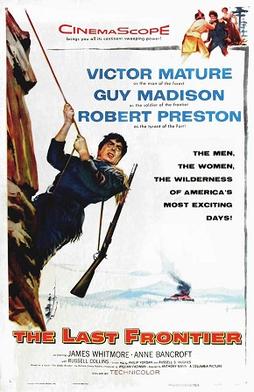
The Last Frontier is a 1955 American Western film directed by Anthony Mann and starring Victor Mature, Guy Madison, Robert Preston, and Anne Bancroft. The film is set during the American Civil War at an isolated army base at the far reaches of the American frontier, where the Indians still far outnumber the whites.
A Town Called Bastard is a 1971 international co-production spaghetti Western. It was shot in Madrid with Robert Shaw, Telly Savalas, Stella Stevens and Martin Landau.
















